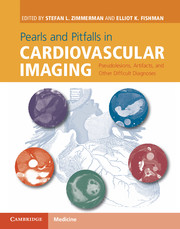 Pearls and Pitfalls in Cardiovascular Imaging
Pearls and Pitfalls in Cardiovascular Imaging from Section 11 - Veins
Published online by Cambridge University Press: 05 June 2015
Imaging description
Persistent left-sided superior vena cava (SVC) is the most common congenital venous anomaly of the chest. In this variant, the left-sided cava receives blood from the left subclavian and left jugular veins and courses inferiorly in the chest, lateral to the left aortic arch and hilum, and drains directly into the coronary sinus. In the vast majority of cases, a separate right-sided SVC is also present. These vessels communicate via a persistent bridging vein in 35% of patients. On chest radiograph, left-sided SVC appears as superior mediastinal widening and a right-sided venous catheter will cross the mediastinum to enter the heart on the left side. A CT will confirm the presence of left-sided SVC coursing lateral to the aortic arch and terminating in the coronary sinus (Figure 100.1). Duplicated inferior vena cava (IVC) and left-sided IVC are two congenital IVC anomalies where a left-sided IVC will be present in the left para-aortic region.
Importance
Anomalous veins can be mistaken for lymphadenopathy or masses, particularly in studies performed without intravenous contrast. The presence of anomalous veins is also important for planning of central venous access.
Typical clinical scenario
Unless the patient has congenital heart disease, these anomalies are often identified incidentally during imaging. Persistent left-sided SVC is present in 0.3% of people, with a higher incidence (4.3%) in those who have congenital heart anomalies.
Differential diagnosis
The differential diagnosis for a large venous structure coursing lateral to the ascending thoracic aorta is partial anomalous pulmonary venous return (Figure 100.2). Unlike a persistent left SVC, which courses inferiorly into the coronary sinus (Figure 100.1), this venous structure courses into the left hilum and branches into the lung parenchyma, along with the left pulmonary arteries. A central line positioned in PAPVR (partial anomalous pulmonary venous return) will course away from the mediastinum at the level of the hilum (Figure 100.2), unlike one positioned in a duplicated SVC, which extends along the heart border into the coronary sinus (Figure 100.1).
To save this book to your Kindle, first ensure [email protected] is added to your Approved Personal Document E-mail List under your Personal Document Settings on the Manage Your Content and Devices page of your Amazon account. Then enter the ‘name’ part of your Kindle email address below. Find out more about saving to your Kindle.
Note you can select to save to either the @free.kindle.com or @kindle.com variations. ‘@free.kindle.com’ emails are free but can only be saved to your device when it is connected to wi-fi. ‘@kindle.com’ emails can be delivered even when you are not connected to wi-fi, but note that service fees apply.
Find out more about the Kindle Personal Document Service.
To save content items to your account, please confirm that you agree to abide by our usage policies. If this is the first time you use this feature, you will be asked to authorise Cambridge Core to connect with your account. Find out more about saving content to Dropbox.
To save content items to your account, please confirm that you agree to abide by our usage policies. If this is the first time you use this feature, you will be asked to authorise Cambridge Core to connect with your account. Find out more about saving content to Google Drive.